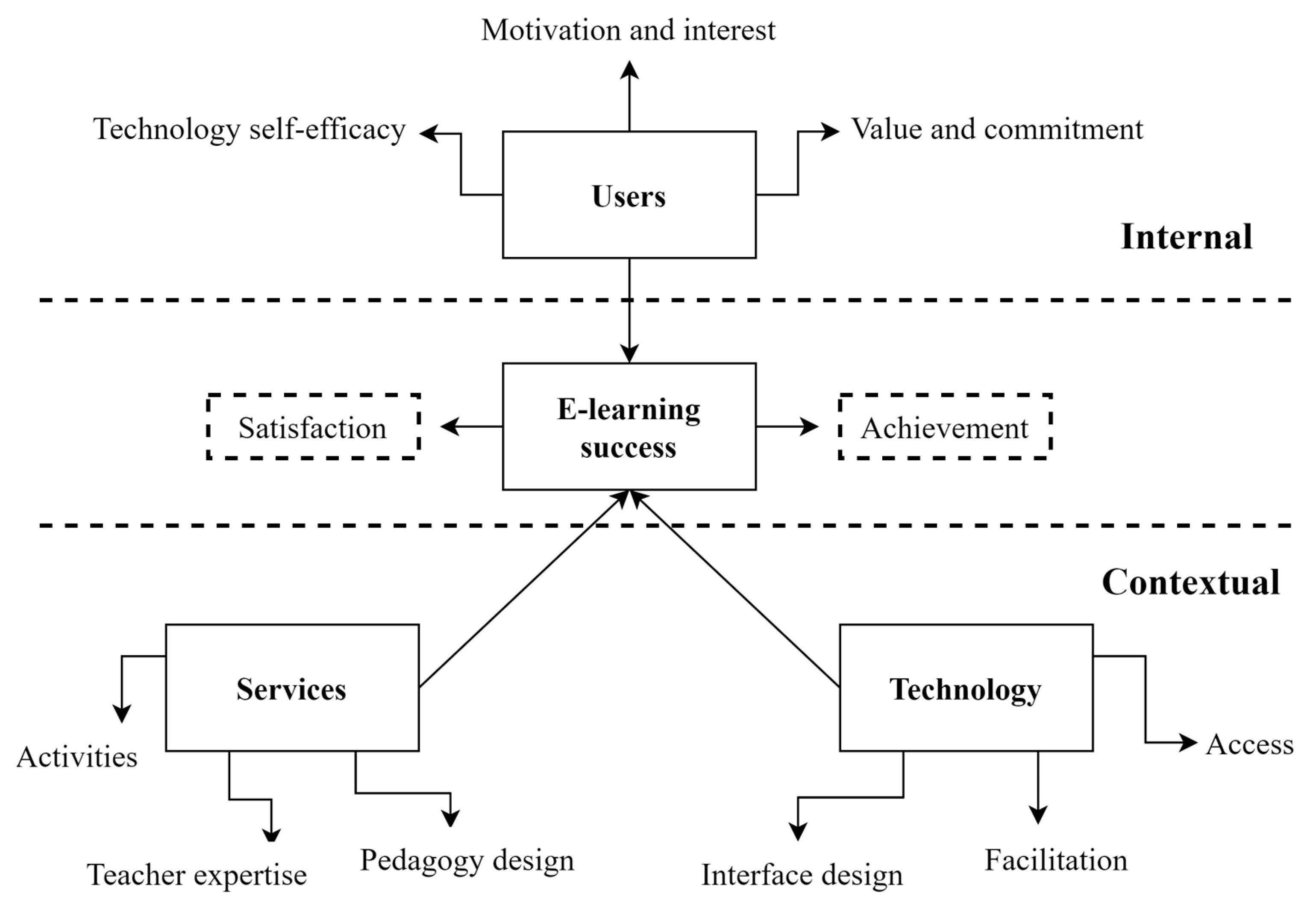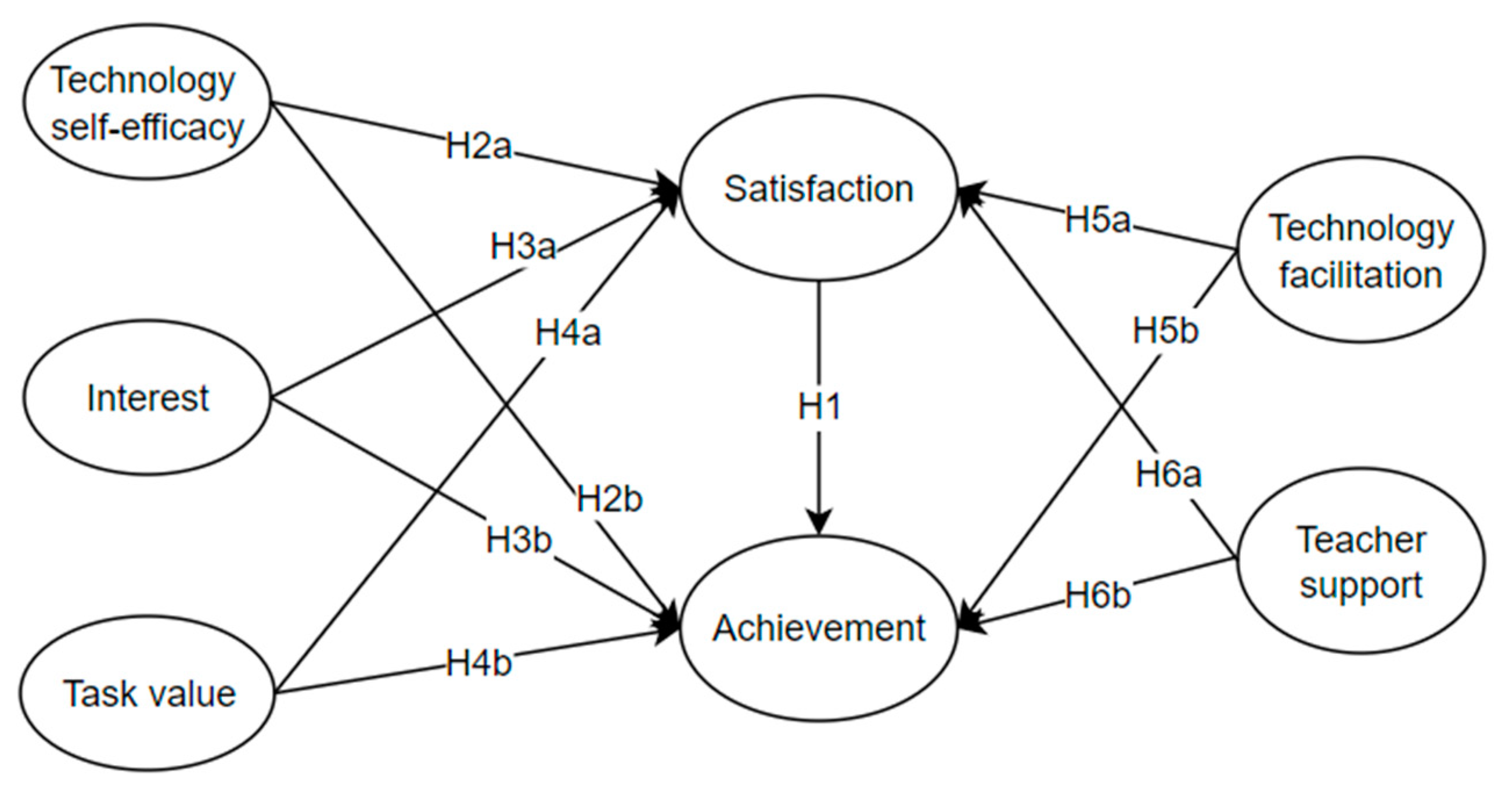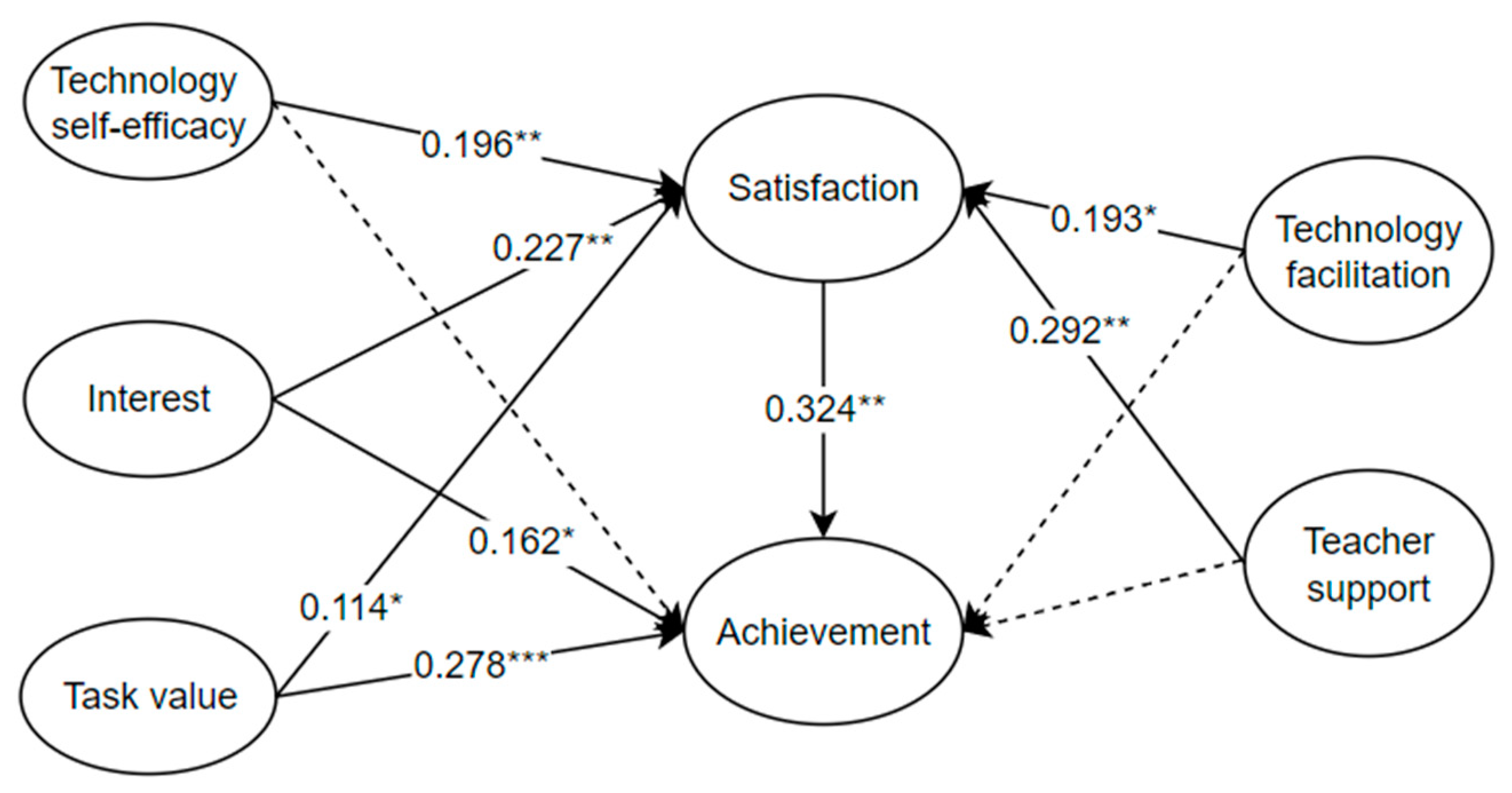What Contributes to Student Language Learning Satisfaction and Achievement with Learning Management Systems?
Abstract
1. Introduction
2. Literature Review
2.1. Learning Management System (LMS)
2.2. The Framework of e-Learning Success
2.3. Satisfaction and Achievement in e-Learning
2.4. Internal Factors
2.4.1. Technology Self-Efficacy
2.4.2. Interest
2.4.3. Task Value
2.5. Contextual Factors
2.5.1. Technology Facilitation
2.5.2. Teacher Support
3. Method
3.1. Participants and Data Collection
3.2. Instrument
3.3. Data Analysis
4. Results
4.1. The Measurement Model
4.2. Structural Model Analysis
5. Discussion
6. Conclusions and Limitations
Author Contributions
Funding
Institutional Review Board Statement
Informed Consent Statement
Data Availability Statement
Conflicts of Interest
References
- Dečman, M. Modeling the acceptance of e-learning in mandatory environments of higher education: The influence of previous education and gender. Comput. Hum. Behav. 2015, 49, 272–281. [Google Scholar] [CrossRef]
- Can, Y.; Bardakci, S.; Sarikaya, E.E. The Effect of Using Student Response System on Achievement and Achievement Emotions in An English Course. Technol. Knowl. Learn. 2021, 28, 79–115. [Google Scholar] [CrossRef]
- Yu, Z. A meta-analysis and bibliographic review of the effect of nine factors on online learning outcomes across the world. Educ. Inf. Technol. 2022, 27, 2457–2482. [Google Scholar] [CrossRef] [PubMed]
- Cheng, M.; Yuen, A.H.K. Student continuance of learning management system use: A longitudinal exploration. Comput. Educ. 2018, 120, 241–253. [Google Scholar] [CrossRef]
- Lavidas, K.; Komis, V.; Achriani, A. Explaining faculty members’ behavioral intention to use learning management systems. J. Comput. Educ. 2022, 9, 707–725. [Google Scholar] [CrossRef]
- Ni, A.; Cheung, A. Understanding secondary students’ continuance intention to adopt AI-powered intelligent tutoring system for English learning. Educ. Inf. Technol. 2023, 28, 3191–3216. [Google Scholar] [CrossRef]
- Kaewsaiha, P.; Chanchalor, S. Factors affecting the usage of learning management systems in higher education. Educ. Inf. Technol. 2021, 26, 2919–2939. [Google Scholar] [CrossRef]
- Chen, X.; Hu, J. ICT-related behavioral factors mediate the relationship between adolescents’ ICT interest and their ICT self-efficacy: Evidence from 30 countries. Comput. Educ. 2020, 159, 104004. [Google Scholar] [CrossRef]
- Cheung, A.C.K.; Slavin, R.E. How features of educational technology applications affect student reading outcomes: A meta-analysis. Educ. Res. Rev. 2012, 7, 198–215. [Google Scholar] [CrossRef]
- Yu, Z. The effects of the superstar learning system on learning interest, attitudes, and academic achievements. Multimed. Tools Appl. 2022, 82, 17947–17962. [Google Scholar] [CrossRef]
- Gamage, S.H.P.W.; Ayres, J.R.; Behrend, M.B. A systematic review on trends in using Moodle for teaching and learning. IJ STEM Ed. 2022, 9, 9. [Google Scholar] [CrossRef]
- Yuen, A.; Cheng, M.; Chan, F. Student satisfaction with learning management systems: A growth model of belief and use. Br. J. Educ. Technol. 2019, 50, 2520–2535. [Google Scholar] [CrossRef]
- Chiu, C.-M.; Wang, E.T.G. Understanding Web-based learning continuance intention: The role of subjective task value. Inf. Manag. 2008, 45, 194–201. [Google Scholar] [CrossRef]
- Almusharraf, N.; Khahro, S. Students Satisfaction with Online Learning Experiences during the COVID-19 Pandemic. Int. J. Emerg. Technol. Learn. (Ijet) 2020, 15, 246–267. [Google Scholar] [CrossRef]
- Han, J.-H.; Sa, H.J. Acceptance of and satisfaction with online educational classes through the technology acceptance model (TAM): The COVID-19 situation in Korea. Asia Pacific. Educ. Rev. 2021, 23, 403–415. [Google Scholar] [CrossRef]
- Wei, H.-C.; Chou, C. Online learning performance and satisfaction: Do perceptions and readiness matter? Distance Educ. 2020, 41, 48–69. [Google Scholar] [CrossRef]
- Pozón-López, I.; Higueras-Castillo, E.; Muñoz-Leiva, F.; Liébana-Cabanillas, F.J. Perceived user satisfaction and intention to use massive open online courses (MOOCs). J. Comput. High Educ. 2021, 33, 85–120. [Google Scholar] [CrossRef]
- Ashfaq, M.; Yun, J.; Yu, S.; Loureiro, S.M.C. I, Chatbot: Modeling the determinants of users’ satisfaction and continuance intention of AI-powered service agents. Telemat. Inform. 2020, 54, 101473. [Google Scholar] [CrossRef]
- Chao, C.-M. Factors Determining the Behavioral Intention to Use Mobile Learning: An Application and Extension of the UTAUT Model. Front. Psychol. 2019, 10, 446627. Available online: https://www.frontiersin.org/article/10.3389/fpsyg.2019.01652 (accessed on 17 February 2022). [CrossRef]
- Prifti, R. Self–efficacy and student satisfaction in the context of blended learning courses. Open Learn. J. Open Distance e-Learn. 2022, 37, 111–125. [Google Scholar] [CrossRef]
- Abuhassna, H.; Al-Rahmi, W.M.; Yahya, N.; Zakaria, M.A.Z.M.; Kosnin, A.B.M.; Darwish, M. Development of a new model on utilizing online learning platforms to improve students’ academic achievements and satisfaction. Int. J. Educ. Technol. High Educ. 2020, 17, 38. [Google Scholar] [CrossRef]
- Sezer, B.; Yilmaz, R. Learning management system acceptance scale (LMSAS): A validity and reliability study. Australas. J. Educ. Technol. 2019, 35, 15–30. [Google Scholar] [CrossRef]
- Shin, W.S.; Kang, M. The use of a mobile learning management system at an online university and its effect on learning satisfaction and achievement. IRRODL 2015, 16, 110–130. [Google Scholar] [CrossRef]
- Al-Nuaimi, M.N.; Al-Emran, M. Learning management systems and technology acceptance models: A systematic review. Educ. Inf. Technol. 2021, 26, 5499–5533. [Google Scholar] [CrossRef]
- Ni, A.; Cheung, A.C.K.; Shi, J. The impact of flipped classroom teaching on college English language learning: A meta-analysis. Int. J. Educ. Res. 2023, 121, 102230. [Google Scholar] [CrossRef]
- Aparicio, M.; Bação, F.; Oliveira, T. An e-Learning Theoretical Framework. J. Educ. Technol. Syst. 2016, 19, 292–307. [Google Scholar]
- Diep, A.-N.; Zhu, C.; Struyven, K.; Blieck, Y. Who or what contributes to student satisfaction in different blended learning modalities? Br. J. Educ. Technol. 2017, 48, 473–489. [Google Scholar] [CrossRef]
- Gu, Y.; Song, C.; Zhong, Y.; Comite, U. The Impact of Teacher Support and Learning Interaction on Online Learning Continuation Willingness: A Flow Experience Perspective. Int. J. Emerg. Technol. Learn. (Ijet) 2022, 17, 78–89. [Google Scholar] [CrossRef]
- Baber, H. Determinants of Students’ Perceived Learning Outcome and Satisfaction in Online Learning during the Pandemic of COVID-19. J. Educ. e-Learn. Res. 2020, 7, 285–292. [Google Scholar] [CrossRef]
- Joo, Y.J.; Lim, K.Y.; Kim, E.K. Online university students’ satisfaction and persistence: Examining perceived level of presence, usefulness and ease of use as predictors in a structural model. Comput. Educ. 2011, 57, 1654–1664. [Google Scholar] [CrossRef]
- Dinh, T.C.; Nguyen, P.B.N. Impact of Internet Self-Efficacy and Self-Regulated Learning on Satisfaction and Academic Achievement in Online Learning: A Case Study in Vietnam. Int. J. Emerg. Technol. Learn. (Ijet) 2022, 17, 269–288. [Google Scholar] [CrossRef]
- Derakhshan, A.; Fathi, J. Grit and Foreign Language Enjoyment as Predictors of EFL Learners’ Online Engagement: The Mediating Role of Online Learning Self-efficacy. Asia-Pacific. Edu. Res. 2023, 1–11. [Google Scholar] [CrossRef]
- Bandura, A. Social Foundations of Thought and Action: A Social Cognitive Theory; Prentice-Hall, Inc.: Englewood Cliffs, NJ, USA, 1986; pp. xiii, 617. ISBN 978-0-13-815614-5. [Google Scholar]
- Compeau, D.R.; Higgins, C.A. Computer Self-Efficacy: Development of a Measure and Initial Test. MIS Q. 1995, 19, 189–211. [Google Scholar] [CrossRef]
- Derakhshesh, A.; Fathi, J.; Mohammad Hosseini, H.; Mehraein, S. An Investigation of the Structural Model of Online Course Satisfaction, Online Learning Self-Efficacy, and Online Learning Climate in the EFL Context. CALL-EJ 2022, 23, 261–281. [Google Scholar]
- Alqurashi, E. Predicting student satisfaction and perceived learning within online learning environments. Distance Educ. 2019, 40, 133–148. [Google Scholar] [CrossRef]
- Xu, J. A profile analysis of online assignment motivation: Combining achievement goal and expectancy-value perspectives. Comput. Educ. 2022, 177, 104367. [Google Scholar] [CrossRef]
- Abdullah, F.; Ward, R. Developing a General Extended Technology Acceptance Model for E-Learning (GETAMEL) by analysing commonly used external factors. Comput. Hum. Behav. 2016, 56, 238–256. [Google Scholar] [CrossRef]
- Fryer, L.K.; Thompson, A.; Nakao, K.; Howarth, M.; Gallacher, A. Supporting self-efficacy beliefs and interest as educational inputs and outcomes: Framing AI and Human partnered task experiences. Learn. Individ. Differ. 2020, 80, 101850. [Google Scholar] [CrossRef]
- Hinderliter, H.; Xie, Y.; Ladendorf, K.; Muehsler, H. Path Analysis of Internal and External Factors Associated with Parental Satisfaction over K-12 Online Learning. Comput. Sch. 2021, 38, 354–383. [Google Scholar] [CrossRef]
- Sutherland, D.; Warwick, P.; Anderson, J. What factors influence student satisfaction with module quality? A comparative analysis in a UK business school context. Int. J. Manag. Educ. 2019, 17, 100312. [Google Scholar] [CrossRef]
- Sánchez-Rosas, J.; Esquivel, S. Instructional Teaching Quality, Task Value, Self-Efficacy, and Boredom: A Model of Attention in Class. Rev. Psicol. 2016, 25, 1–20. [Google Scholar] [CrossRef]
- Qin, C.; Huang, W.; Hew, K.F. Using the community of inquiry framework to develop an educational chatbot: Lesson learned from a mobile instant messaging learning environment. In Proceedings of the ICCE 2020—28th International Conference on Computers in Education, Online, 23–27 November 2020; Volume 1, pp. 69–74. Available online: https://www.scopus.com/inward/record.uri?eid=2-s2.0-85099481385&partnerID=40&md5=2581f4c222a067c6cee44794922b726d (accessed on 15 May 2022).
- Cheng, Y.-M. Extending the expectation-confirmation model with quality and flow to explore nurses’ continued blended e-learning intention. Inf. Technol. People 2014, 27, 230–258. [Google Scholar] [CrossRef]
- Hu, L.; Bentler, P.M. Cutoff criteria for fit indexes in covariance structure analysis: Conventional criteria versus new alternatives. Struct. Equ. Model. A Multidiscip. J. 1999, 6, 1–55. [Google Scholar] [CrossRef]
- Kline, R.B. Principles and Practice of Structural Equation Modeling, 4th ed.; The Guilford Press: New York, NY, USA, 2015; ISBN 978-1-4625-2334-4. [Google Scholar]
- Fornell, C.; Larcker, D.F. Evaluating Structural Equation Models with Unobservable Variables and Measurement Error. J. Mark. Res. 1981, 18, 39–50. [Google Scholar] [CrossRef]
- Langan, A.M.; Harris, W.E. National student survey metrics: Where is the room for improvement? High Educ. 2019, 78, 1075–1089. [Google Scholar] [CrossRef]
- Venkatesh, V.; Morris, M.G.; Davis, G.B.; Davis, F.D. User Acceptance of Information Technology: Toward a Unified View. MIS Q. 2003, 27, 425. [Google Scholar] [CrossRef]
- Hatlevik, O.E.; Throndsen, I.; Loi, M.; Gudmundsdottir, G.B. Students’ ICT self-efficacy and computer and information literacy: Determinants and relationships. Comput. Educ. 2018, 118, 107–119. [Google Scholar] [CrossRef]



| Factors | Mean | SD | Skewness | Kurtosis |
|---|---|---|---|---|
| Technology self-efficacy | 4.307 | 1.015 | −0.592 | 0.293 |
| Interest | 4.230 | 1.178 | −0.630 | −0.094 |
| Task value | 3.748 | 1.624 | −0.253 | −0.383 |
| Technology facilitation | 4.246 | 1.201 | −0.554 | −0.270 |
| Teacher support | 4.429 | 1.091 | −0.805 | 0.451 |
| Satisfaction | 4.263 | 1.123 | −0.657 | 0.020 |
| Achievement | 89.746 | 19.276 | −0.395 | 0.204 |
| Factors | TSE | INT | TSV | TF | TS | SA | ACH |
|---|---|---|---|---|---|---|---|
| Technology self-efficacy | 0.875 | ||||||
| Interest | 0.593 ** | 0.907 | |||||
| Task value | 0.373 ** | 0.624 ** | 0.902 | ||||
| Technology facilitation | 0.560 ** | 0.642 ** | 0.570 ** | 0.907 | |||
| Teacher support | 0.655 ** | 0.685 ** | 0.573 ** | 0.771 ** | 0.878 | ||
| Satisfaction | 0.663 ** | 0.735 ** | 0.608 ** | 0.732 ** | 0.773 ** | 0.921 | |
| Achievement | 0.451 ** | 0.628 ** | 0.614 ** | 0.590 ** | 0.594 ** | 0.672 ** | - |
| Measures | Items | Factor Loading | CR | AVE |
|---|---|---|---|---|
| Technology self-efficacy | 5 | 0.854–0.915 | 0.942 | 0.765 |
| Interest | 5 | 0.873–0.941 | 0.959 | 0.824 |
| Task value | 4 | 0.879–0.920 | 0.946 | 0.814 |
| Technology facilitation | 3 | 0.872–0.941 | 0.933 | 0.824 |
| Teacher support | 5 | 0.772–0.911 | 0.943 | 0.772 |
| Satisfaction | 4 | 0.887–0.961 | 0.958 | 0.850 |
| Satisfaction | Achievement | |||
|---|---|---|---|---|
| Direct Effects | Direct Effects | Indirect Effects | Total Effects | |
| Technology self-efficacy | 0.196 ** | −0.031 | 0.063 | 0.032 |
| Interest | 0.227 ** | 0.162 * | 0.074 * | 0.236 ** |
| Task value | 0.114 * | 0.278 *** | 0.037 * | 0.315 *** |
| Technology facilitation | 0.193 * | 0.085 | 0.063 | 0.147 |
| Teacher support | 0.292 ** | 0.018 | 0.095 * | 0.112 |
| Satisfaction | - | 0.324 ** | - | 0.324 ** |
| R2 | - | 0.548 *** | - | - |
Disclaimer/Publisher’s Note: The statements, opinions and data contained in all publications are solely those of the individual author(s) and contributor(s) and not of MDPI and/or the editor(s). MDPI and/or the editor(s) disclaim responsibility for any injury to people or property resulting from any ideas, methods, instructions or products referred to in the content. |
© 2024 by the authors. Licensee MDPI, Basel, Switzerland. This article is an open access article distributed under the terms and conditions of the Creative Commons Attribution (CC BY) license (https://creativecommons.org/licenses/by/4.0/).
Share and Cite
Li, H.; Ni, A. What Contributes to Student Language Learning Satisfaction and Achievement with Learning Management Systems? Behav. Sci. 2024, 14, 271. https://doi.org/10.3390/bs14040271
Li H, Ni A. What Contributes to Student Language Learning Satisfaction and Achievement with Learning Management Systems? Behavioral Sciences. 2024; 14(4):271. https://doi.org/10.3390/bs14040271
Chicago/Turabian StyleLi, Hanxue, and Aohua Ni. 2024. "What Contributes to Student Language Learning Satisfaction and Achievement with Learning Management Systems?" Behavioral Sciences 14, no. 4: 271. https://doi.org/10.3390/bs14040271
APA StyleLi, H., & Ni, A. (2024). What Contributes to Student Language Learning Satisfaction and Achievement with Learning Management Systems? Behavioral Sciences, 14(4), 271. https://doi.org/10.3390/bs14040271




